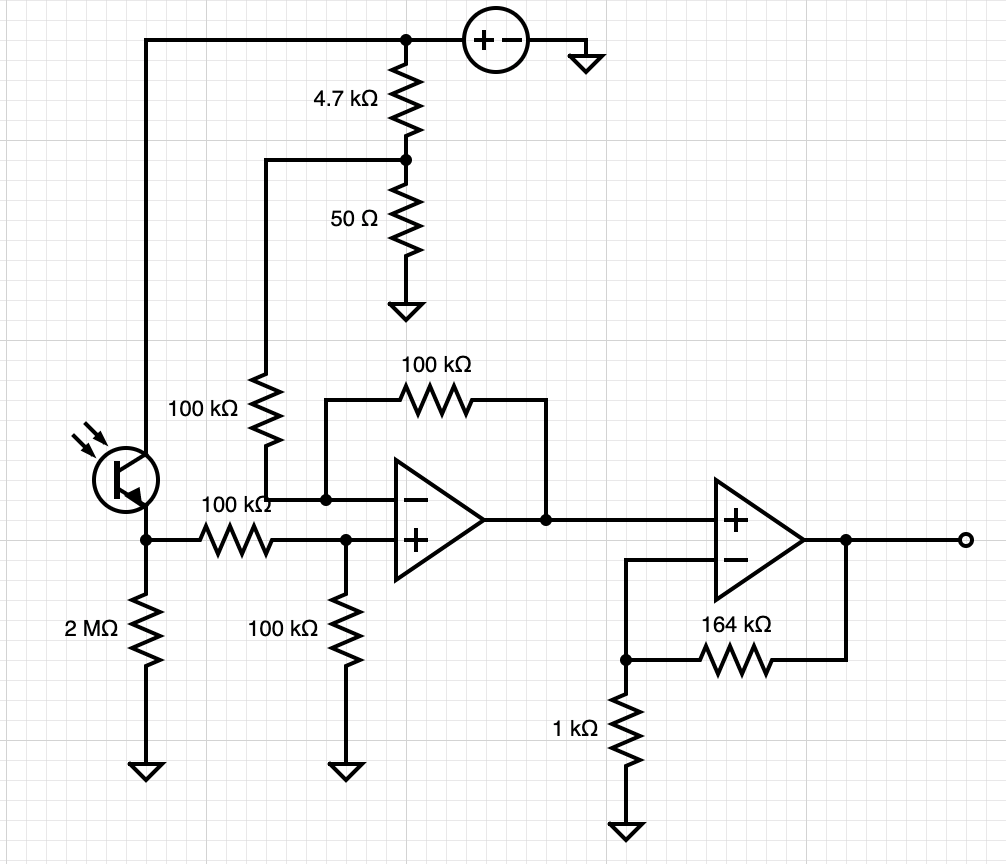I am working on a project in which I am using an IR phototransistor to detect changing low levels of light. Currently with very high load resistance I can get a reading of 40-60 mV but I would like to stretch this out to approx 0 - 3.3 V so I have designed cascading op amps to do so. The issue being now, I'm not sure where to put the load resistor. The resistor determines the sensitivity but when placed in conjunction with the cascading amps the signal of the transistor goes to 0 V. Any suggestions? I have attached a rough schematic. Thanks in advance ]1
]1
-
\$\begingroup\$ I think you need a photodiode, not a phototransistor (which will also require a different circuit). Also, I think you have a typo with 3.3mV. \$\endgroup\$– DKNguyenCommented May 7, 2019 at 14:58
-
\$\begingroup\$ Normally one uses a TIA op amp config for high GBW. What is your spec for GBW? I would use a low cost daylight blocking IR PD for normal levels which is very consistent and has none of the wide variance issues due to hFE in PT's. Load R affects gain and BW inversely \$\endgroup\$– D.A.S.Commented May 7, 2019 at 15:29
-
\$\begingroup\$ Do you need to tolerate SUNLIGHT? or 60Hz? If so, a DC_nulling feedback approach is needed. \$\endgroup\$– analogsystemsrfCommented May 7, 2019 at 15:31
-
\$\begingroup\$ Why in the world do you have that 4.7k/50 ohm combination? It will reduce the voltage to the phototransistor by a factor of 100. \$\endgroup\$– WhatRoughBeastCommented May 7, 2019 at 16:07
-
1\$\begingroup\$ Photodiodes are faster (higher bandwidth), lower noise, more linear, and have a larger dynamic range. They also tend to have better characterization. The main advantage of a phototransistor is that it's simpler to use since it has higher gain so you don't need so much amplification. But your phototransistor amplifier circuit is already a lot bigger than a TIA so it's a moot point. \$\endgroup\$– DKNguyenCommented May 7, 2019 at 18:49
1 Answer
I suspect that, by "nothing", you mean a level about 1/10 of your raw reading. The two 100k resistors on the input of the first op amp produce a 200k resistance in parallel with the 2M resistor. Since the phototransistor has a current output, the voltage across the new load will be about 1/10 the original, or something like 5 mV.
EDIT - You can try something like this

simulate this circuit – Schematic created using CircuitLab
Note that this will not give the exact zero of your original circuit. I assume that your offset is caused by a) leakage in the phototransistor, and b) op amp offset. In principle, if your original gives 0 volts for 0 light, the new circuit will give about 3 mV. You can adjust this by varying R2.
-
\$\begingroup\$ Yep you're totally right. Is there a way I can bring the signal of the phototransistor to the input of the op amp without that? I would switch to the diode and TIA but I don't exactly have the time \$\endgroup\$– Ryan BCommented May 7, 2019 at 19:56
-
-
\$\begingroup\$ how'd you come up with this configuration? \$\endgroup\$– Ryan BCommented May 9, 2019 at 14:26
-
\$\begingroup\$ the idea with the previous was to take the signal and stretch it from say 30-50 mv to 0 - 3.3 V \$\endgroup\$– Ryan BCommented May 9, 2019 at 15:53
-
\$\begingroup\$ @RyanB - In your circuit, the left-hand op amp and its associated 4 100k resistors form a unity-gain differential amp which subtracts about 3 mV from the raw load resistor voltage (ignoring the extra loading effects that I pointed out). This is followed by a non-inverting amp with gain equaling 165. I've maintained the gain, and used the 3 mV directly on the feedback network. If you want less gain, choose a different set of resistors. For instance, if you want 30 mV to produce 3.3 volts, you need a gain of 110, so the 164k resistor should be 109k. \$\endgroup\$ Commented May 10, 2019 at 2:06
